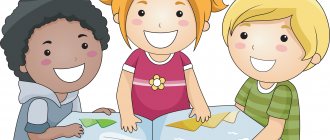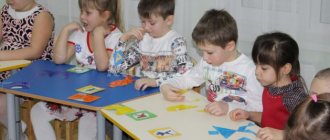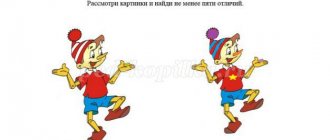Types of didactic games
| Types of games | Description |
| Games with objects (toys) | This type of game is based on the interaction of children with objects. In this way, children learn to compare objects, establish similarities and differences between them, and become familiar with the properties of objects, size, and color. |
| Board-printed games | With the help of these games, the child gets acquainted with the world around him, the world of animals and plants, the emotional world, etc. Printed board games can be presented in the form of: “lotto”, “dominoes”, “paired pictures”. With their help, you can successfully develop speech skills, mathematical abilities, logic, attention, learn to model life patterns and make decisions, and develop self-control skills. |
| Word games | Word games are an effective method of fostering independent thinking and speech development in children. They are built on the words and actions of the players; children independently solve various mental problems: they describe objects, highlighting their characteristic features, guess them from the description, find similarities and differences between these objects and natural phenomena. |
Next, I invite you to get acquainted with the printed board games that I have developed for working with preschool children.
MAGAZINE Preschooler.RF
Didactic game as a means of psychological development of a preschool childOlga Ivanovna Bugonina, psychologist of the MB preschool educational institution “Kindergarten No. 250” of a combined type, Novokuznetsk
Modern conditions are characterized by the humanization of the educational process, an appeal to the child’s personality, the development of his best qualities, and the formation of a versatile and full-fledged personality. The implementation of this task objectively requires a qualitatively new approach to teaching and raising children, and organizing the entire educational process. First of all, the methods, means and methods of teaching and education must undergo changes. In this regard, game forms of teaching and upbringing, in particular, didactic games, acquire particular importance.
Psychologists believe that each period of a child’s life and development is characterized by a certain leading type of activity: in preschool age, this is play. Therefore, it is through didactic games that the desired result can be achieved: to develop cognitive processes in children (attention, memory, thinking), to form the initial skills of counting, writing, and reading in preschool children.
There are many definitions of play in general and didactic play in particular. Let's list some of them.
E.V. Karpova views the game as:
1) a special relationship of the individual to the world around him;
2) the child’s special activity, which changes and develops as his subjective activity;
3) a type of activity specially assigned to the child and learned by him (or attitude towards the world);
4) special content of learning;
5) activities during which the child’s psyche develops;
6) socio-pedagogical form of organizing children's life and “children's society” .
Didactic games E.V. Karpova defines it as “a type of games with rules, specially created by pedagogy for the purpose of teaching and raising children”
Didactic games are specially created games adapted for educational purposes.
The didactic game has a certain structure. Structure is the main elements that characterize the game as a form of learning and gaming activity at the same time. The following components of the didactic game are distinguished:
- didactic task;
- game task;
- game actions;
- rules of the game;
- result (summarizing).
The didactic task is determined by the purpose of the teaching and educational impact. It is formulated by the teacher and reflects his teaching activities.
The game task is carried out by children. The didactic task in a didactic game is realized through a game task. It determines play actions and becomes the task of the child himself. The most important thing: the didactic task in the game is deliberately disguised and appears before the children in the form of a game plan (task).
Game actions are the basis of the game. The more varied the game activities, the more interesting the game itself is for children and the more successfully cognitive and gaming tasks are solved. In different games, game actions differ in their focus and in relation to the players. This, for example, could be solving riddles, spatial transformations, etc. They are related to the game concept and come from it. Game actions are means of realizing the game plan, but also include actions aimed at fulfilling the didactic task.
Rules of the game. Their content and focus are determined by the general tasks of forming the child’s personality, cognitive content, game tasks and game actions. The rules contain moral requirements for the relationships between children and for their compliance with norms of behavior. In a didactic game, the rules are given. With the help of rules, the teacher controls the game, the processes of cognitive activity, and the behavior of children. The rules also influence the solution of the didactic task - they imperceptibly limit the actions of children and direct their attention to completing a specific task.
Summing up (result) is carried out immediately after the end of the game. This could be scoring; identifying children who performed the game task better; determination of the winning team, etc. It is necessary to note the achievements of each child and emphasize the successes of lagging children.
When conducting the game, it is necessary to preserve all structural elements, since it is with their help that didactic tasks are solved. In the situation of a didactic game, knowledge is absorbed better. The didactic task is hidden from children. This makes the game a special form of play-based learning, when children most often unintentionally acquire knowledge, skills, and abilities. The relationship between children and the teacher is determined not by the learning situation, but by the game.
Thus, a didactic game is a game only for a child. In a didactic game, knowledge acquisition acts as a side effect.
The purpose of the didactic game and game techniques is to facilitate the transition to educational tasks and make it gradual.
The following basic conditions for conducting a didactic game can be distinguished:
- The teacher has certain knowledge and skills regarding didactic games.
- Expressiveness of the game. This ensures children's interest, desire to listen, and participate in the game.
- The need to include the teacher in the game. He is both a participant and the leader of the game. The teacher must ensure the progressive development of the game (inform the rules, monitor compliance with the time limit) in accordance with educational and educational tasks, but at the same time not exert pressure and play a secondary role. It is imperceptible for children to direct the game in the right direction.
- It is necessary to optimally combine entertainment and learning.
- Means and methods that increase children’s emotional attitude to the game should be considered not as an end in itself, but as a path leading to the fulfillment of didactic tasks.
- There should be an atmosphere of respect, mutual understanding, trust and empathy between the teacher and children.
- The visuals used in the didactic game should be simple and succinct.
Literature
- Karpova E.V. Didactic games in the initial period of learning. Yaroslavl: "Academy of Development" , 1997. -240 p.
- Kudykina N.V. Didactic games and entertaining tasks for 1st grade. Kyiv, 1989. - 246 p.
- Shvaiko G.V. Didactic games in kindergarten. M.: Prolsveshchenie, 1982. – 216 p.
| Next > |
Didactic game "Locomotive"
The game is aimed at developing visual-figurative thinking, elements of logical thinking, the ability to group objects according to their functional purpose, select generalizing words, develop visual memory, and develop attention.
The kit includes:
- 8 trains;
- a set of trailers with wild animals, pets, fruits, vegetables, clothes, dishes, toys, furniture.
From 1 to 8 children can take part in the game. The game is aimed at children aged 4 to 7 years.
Rules of the game: The trailers are laid out in front of the child, upside down. Then the teacher suggests taking one trailer at a time and attaching them to a specific train. It is discussed in advance with the child that carriages, for example, with domestic animals, will be attached to the blue train, and to the orange train, with wild animals (instead of animals, you can use another option for classification, for example, fruits and vegetables). Next, the teacher can ask the child to close his eyes, and at this time turn over some trailers and invite the child to remember what was in these trailers, or he can swap the trailers and ask what has changed.
Downloaded: 1515, size: 1.7 MB, date: April 14. 2020
Didactic game “Hide the toy”
The game is aimed at developing attention, memory, and developing the ability to correlate colors.
The kit includes:
- 6 houses depicting toys;
- 6 windows.
The game is intended for individual use and is aimed at children aged 3 years and older.
Rules of the game: Houses are laid out in front of the child in any order and they are asked to first name the toys shown in the window, and then cover these windows with a card of the corresponding color. Then the adult asks the child to remember in which house the ball, doll, etc. is hidden.
Downloads: 1377, size: 480.1 KB, date: April 14. 2020
Card index of psychological games for preschool children.
Psychological games for preschool children
Game "Help a friend"
Goal: Formation of a sense of responsibility and trust in each other, activation of positive emotions.
I suggest you divide into pairs, one closes his eyes. The couple is given a sheet containing a drawing with the missing part. The participant, with his eyes closed, completes the drawing at the verbal prompt of his friend.
The game "Threads that connect".
Purpose of the game: To develop the child’s communication abilities, to teach him to be attentive to his personal qualities and the personal qualities of his peers, to understand the differences in people’s characters, and the ability to appreciate them.
Equipment: Ball of thread.
Description: Participants sit in a circle, the leader, holding a ball in his hands, wraps a thread around his index finger, and then throws the ball to the participant sitting on the left, asking him a question about his preferences. The questions may be different, for example:
What do you love to do most?
What kind of people do you like? - and so on.
The participant must catch the ball, in turn wind the thread around his finger, answer the question and throw the ball, accompanied by his question, to the next player clockwise.
Game "Fulfill the condition"
Goal: Develop the ability to interact in a team, identify individual characteristics of yourself and your peers, and unite the children's team.
Description: Children move freely around the room. Suddenly, an adult claps his hands and announces the condition that all players must split into groups as quickly as possible. The conditions can be very different, for example: getting together in pairs with the same eye and hair color; gather in groups of 2, 3, etc. person.
Game "Common House"
Purpose of the game. Develop communication skills.
Equipment. Sheet of A4 paper, colored pencils.
Description. Two participants are invited to jointly draw a house, and then talk about who lives in it and what they do.
"Seven-flowered flower"
The game helps children assess their condition and analyze their behavior.
An adult prepares flowers from cardboard in advance. Each of the 7 petals has faces expressing emotions. The child looks at the petals, names the emotion and says when he was in one state or another. You can conduct similar classes many times throughout the year, and at the end of the year discuss with your child whether his views on others and himself have changed. For example, if at the beginning of the year a child said that he is happy when they give him gifts, and after 2-3 months he said that most often he is happy when other children accept him in the game, then you can talk about this and ask why his ideas have changed.
"Magic bag"
Before this game, we discuss with the child what his mood is now, how he feels, maybe he is offended by someone.
Then invite the child to put all negative emotions, anger, resentment, sadness into a magic bag. This bag, with all the bad things in it, is tied tightly. You can use another “magic bag” from which the child can take the positive emotions he wants. The game is aimed at awareness of your emotional state and liberation from negative emotions.
“Why Mom Loves Me”
Goal: increasing the importance of the child in the eyes of the children around him. All children sit in a circle. Each child takes turns telling everyone why his mother loves him. Then you can ask one of the children (who wishes) to repeat why the mother loves each child present in the group. If he has difficulty, other children can help him. After this, discuss with the children whether they were pleased to know that everything they said was remembered by the other children. Children usually come to the conclusion that they need to be attentive to others and listen to them.
Games with clothespins “Find a pair”
The game is aimed at developing observation, attention, accuracy of visual perception, and the ability to select paired pictures according to their meaning.
Before starting the game, the circles must be cut out and attached to clothespins; the game discs are also cut out.
The kit includes:
- 4 game discs;
- 32 circles from images pictures.
Rules of the game: The player is offered a disk to which he must attach clothespins with corresponding pictures according to their meaning. The following tasks are offered for the game: “Find the shadow”, “Mom and baby”, “Tops and roots”, “Find a pair”.
Downloads: 1292, size: 1.3 MB, date: April 14. 2020






